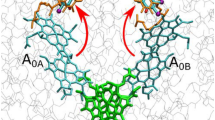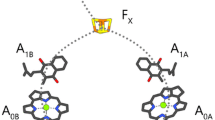Abstract
Transient electron paramagnetic resonance and pulsed electron-nuclear double resonance (ENDOR) spectra of the state \( P_{700}^{ \cdot + } A_{1}^{ \cdot - } \) in photosystem I containing a series of non-native naphthoquinones (NQs) are presented. Previous studies have shown that quinones bind to the A1 site with only one of their carbonyl groups H-bonded to the protein and that the asymmetric H-bond produces an odd alternant distribution of the spin density within the quinone. It is known that the native phylloquinone binds with its methyl group meta and its phytyl tail ortho to the H-bonded carbonyl. Monosubstituted NQs with short alkyl chains have been found to bind preferentially with their alkyl side groups meta to the H-bonded carbonyl. The selectivity of the binding site toward methyl and short chain substituents is studied by incorporating disubstituted NQs that have a methyl group at the 2-position and a short chain at the 3-position of the quinone ring. The hyperfine couplings (hfcs) of the methyl group protons are sensitive to the spin density distribution on the quinone and are used to deduce the position of the methyl group relative to the H-bonded carbonyl. The measured methyl proton hfcs indicate that the disubstituted quinones bind exclusively with their methyl group in the meta position relative to the H-bonded carbonyl and no evidence for binding with the methyl group in the ortho position is found. The disubstituted quinones have also been chosen to study the effect of electron withdrawing substituents on the spin density distribution. When the short chain contains electronegative atoms such as sulfur or chlorine, the methyl proton hfcs of the quinone in the A1 binding site are found to be significantly larger than those of 2-methyl-1,4-naphthoquinone and phylloquinone in the same environment. Solution ENDOR measurements of the quinone radical anions in isopropanol and density functional theory (DFT) calculations in vacuo show that this increase in the hfcs is mostly intrinsic to the quinones due to the electron-withdrawing ability of the short chain and is not a result of differences in the binding to the protein. The DFT calculations suggest that the main reason for the increased methyl proton hfcs is delocalization of the singly occupied molecular orbital onto the side chain, which leads to an increase of the spin density on the neighboring carbon, which carries methyl group.







Similar content being viewed by others
References
J. Golbeck (ed.), Photosystem I. The Light-Driven Plastocyanin:Ferredoxin Oxidoreductase (Springer, Dordrecht, 2006)
T. Wydrzynski, K. Satoh (eds.), Photosystem II. The Light-Driven Water:Plastoquinone Oxidoreductase (Springer, Dordrecht, 2005)
N. Srinivasan, J.H. Golbeck, Biochim. Biophys. Acta 1787, 1057–1088 (2009)
V. Petrouleas, A.R. Crofts, in Photosystem II. The Light-Driven Water:Plastoquinone Oxidoreductase, ed. by T. Wydrzynski, K. Satoh (Springer, Dordrecht, 2005), pp. 177–206
A. Krieger, A.W. Rutherford, G.N. Johnson, Biochim Biophys. Acta 1229, 193–201 (1995)
K. Brettel, Biochim. Biophys. Acta 1318, 322–373 (1997)
R.C. Prince, M.R. Gunner, P.L. Dutton, in Function of Quinones in Energy Conserving Systems, ed. by B.L. Trumpower (Academic Press, New York, 1982)
R.C. Prince, P.L. Dutton, J.M. Bruce, FEBS Lett. 160, 273–276 (1983)
T.W. Johnson, G.Z. Shen, B. Zybailov, D. Kolling, R. Reategui, S. Beauparlant, I.R. Vassiliev, D.A. Bryant, A.D. Jones, J.H. Golbeck, P.R. Chitnis, J. Biol. Chem. 275, 8523–8530 (2000)
B. Zybailov, A. van der Est, S.G. Zech, C. Teutloff, T.W. Johnson, G.Z. Shen, R. Bittl, D. Stehlik, P.R. Chitnis, J.H. Golbeck, J. Biol. Chem. 275, 8531–8539 (2000)
A.Y. Semenov, I.R. Vassiliev, A. van der Est, M.D. Mamedov, B. Zybailov, G.Z. Shen, D. Stehlik, B.A. Diner, P.R. Chitnis, J.H. Golbeck, J. Biol. Chem. 275, 23429–23438 (2000)
I. Sieckman, A. van der Est, H. Bottin, P. Setif, D. Stehlik, FEBS Lett. 284, 98–102 (1991)
R.R. Rustandi, S.W. Snyder, J. Biggins, J.R. Norris, M.C. Thurnauer, Biochim. Biophys. Acta 1101, 311–320 (1992)
R.R. Rustandi, S.W. Snyder, L.L. Feezel, T.J. Michalski, J.R. Norris, M.C. Thurnauer, J. Biggins, Biochemistry 29, 8030–8032 (1990)
S.W. Snyder, R.R. Rustandi, J. Biggins, J.R. Norris, M.C. Thurnauer, Proc. Natl. Acad. Sci. USA 88, 9895–9896 (1991)
J. Biggins, P. Mathis, Biochemistry 27, 1494–1500 (1988)
S. Itoh, M. Iwaki, Biochemistry 30, 5340–5346 (1991)
M. Iwaki, S. Itoh, in Electron Transfer in Inorganic, Organic and Biological Systems: eds. by JR. Bolton, N. Mataga, GL. McLendon (ACS, Washington, USA, 1991), pp 163–178
T.W. Johnson, B. Zybailov, A.D. Jones, R. Bittl, S. Zech, D. Stehlik, J.H. Golbeck, P.R. Chitnis, J. Biol. Chem. 276, 39512–39521 (2001)
Y.N. Pushkar, J.H. Golbeck, D. Stehlik, H. Zimmermann, J. Phys. Chem. B 108, 9439–9448 (2004)
J. Niklas, B. Epel, M.L. Antonkine, S. Sinnecker, M.E. Pandelia, W. Lubitz, J. Phys. Chem. B 113, 10367–10379 (2009)
D. Stehlik, in Photosystem I. The Light-Driven Plastocyanin:Ferredoxin Oxidoreductase, ed. by J. Golbeck (Springer, Dordrecht, 2006), pp. 361–386
A. van der Est, Transient EPR: using spin polarization in sequential radical pairs to study electron transfer in photosynthesis. Photosynth Res (2009)
O.G. Poluektov, S.V. Paschenko, L.M. Utschig, K.V. Lakshmi, M.C. Thurnauer, J. Am. Chem. Soc. 127, 11910–11911 (2005)
A. van der Est, I. Sieckmann, W. Lubitz, D. Stehlik, Chem. Phys. 194, 349–359 (1995)
Y. Sakuragi, B. Zybailov, G.Z. Shen, A.D. Jones, P.R. Chitnis, A. van der Est, R. Bittl, S. Zech, D. Stehlik, J.H. Golbeck, D.A. Bryant, Biochemistry 41, 394–405 (2002)
Y.N. Pushkar, D. Stehlik, M. van Gastel, W. Lubitz, J. Mol. Struct. 700, 233–241 (2004)
Y.N. Pushkar, O. Ayzatulin, D. Stehlik, Appl. Magn. Reson. 28, 195–211 (2005)
Y.N. Pushkar, I. Karyagina, D. Stehlik, S. Brown, A. van der Est, J. Biol. Chem. 280, 12382–12390 (2005)
C.E. Fursman, C. Teutloff, R. Bittl, J. Phys. Chem. B 106, 9679–9686 (2002)
R. Bittl, S. Zech, C. Teutloff, W. Krabben, W. Lubitz, in Photosynthesis: Mechanisms and Effects, ed. by G. Garab (Kluwer, Dordrecht, 1998), pp. 509–514
C. Teutloff, R. Bittl, W. Lubitz, Appl. Magn. Reson. 26, 5–21 (2004)
B. Epel, J. Niklas, M.L. Antonkine, W. Lubitz, Appl. Magn. Reson. 30, 311–327 (2006)
S.E.J. Rigby, M.C.W. Evans, P. Heathcote, Biochemistry 35, 6651–6656 (1996)
C. Teutloff, F. MacMillan, R. Bittl, F. Lendzian, W. Lubitz, in Photosynthesis: Mechanisms and Effects, ed. by G. Garab (Kluwer, Dordrecht, 1998), pp. 607–610
W. Lubitz, G. Feher, Appl. Magn. Reson. 17, 1–48 (1999)
Y.N. Pushkar, S.G. Zech, D. Stehlik, S. Brown, A. van der Est, H. Zimmermann, J. Phys. Chem. B 106, 12052–12058 (2002)
S.G. Zech, A.J. van der Est, R. Bittl, Biochemistry 36, 9774–9779 (1997)
B. Epel, J. Niklas, S. Sinnecker, H. Zimmermann, W. Lubitz, J. Phys. Chem. B 110, 11549–11560 (2006)
J.M. Frisch, W.G. Trucks, B.H. Schlegel, E.G. Scuseria, A.M. Robb, R.J. Cheeseman, A.J.J. Montgomery, T. Vreven, N.K. Kudin, C.J. Burant, M.J. Millam, S.S. Iyengar, J. Tomasi, V. Barone, B. Mennucci, M. Cossi, G. Scalmani, N. Rega, A.G. Petersson, H. Nakatsuji, M. Hada, M. Ehara, K. Toyota, R. Fukuda, J. Hasegawa, M. Ishida, T. Nakajima, Y. Honda, O. Kitao, H. Nakai, M. Klene, X. Li, E.J. Knox, P.H. Hratchian, B.J. Cross, C. Adamo, J. Jaramillo, R. Gomperts, E.R. Stratmann, O. Yazyev, J.A. Austin, R. Cammi, C. Pomelli, W.J. Ochterski, Y.P. Ayala, K. Morokuma, A.G. Voth, J.J. Dannenberg, G.V. Zakrzewski, S. Dapprich, D.A. Daniels, C.M. Strain, O. Farkas, K.D. Malick, D.A. Rabuck, K. Raghavachari, B.J. Foresman, V.J. Ortiz, Q. Cui, G.A. Baboul, S. Clifford, J. Cioslowski, B.B. Stefanov, G. Liu, A. Liashenko, P. Piskorz, I. Komaromi, L.R. Martin, J.D. Fox, T. Keith, A.M. Al-Laham, Y.C. Peng, A. Nanayakkara, M. Challacombe, P.W.M. Gill, B. Johnson, W. Chen, W.M. Wong, C. Gonzalez, J.A. Pople, Gaussian 03, Revision C.02 (Gaussian Inc., Wallingford, 2004)
S.M. Mattar, A.H. Emwas, A.D. Stephens, Chem. Phys. Lett. 363, 152–160 (2002)
A.D. Becke, J. Chem. Phys. 98, 1372–1377 (1993)
C.T. Lee, W.T. Yang, R.G. Parr, Phys. Rev. B 37, 785–789 (1988)
M.M. Francl, W.J. Pietro, W.J. Hehre, J.S. Binkley, M.S. Gordon, D.J. Defrees, J.A. Pople, J. Chem. Phys. 77, 3654–3665 (1982)
P.C. Hariharan, J.A. Pople, Theor. Chim. Acta 28, 213–222 (1973)
P.C. Hariharan, J.A. Pople, Mol. Phys. 27, 209–214 (1974)
W.J. Hehre, R. Ditchfie, J.A. Pople, J. Chem. Phys. 56, 2257–2261 (1972)
V.A. Rassolov, J.A. Pople, M.A. Ratner, T.L. Windus, J. Chem. Phys. 109, 1223–1229 (1998)
A. van der Est, Biochim. Biophys. Acta 1507, 212–225 (2001)
Y.E. Kandrashkin, W. Vollmann, D. Stehlik, K. Salikhov, A. Van der Est, Mol. Phys. 100, 1431–1443 (2002)
S.G. Zech, W. Hofbauer, A. Kamlowski, P. Fromme, D. Stehlik, W. Lubitz, R. Bittl, J. Phys. Chem. B 104, 9728–9739 (2000)
W. Xu, P. Chitnis, A. Valieva, A. van der Est, Y.N. Pushkar, M. Krzystyniak, C. Teutloff, S.G. Zech, R. Bittl, D. Stehlik, B. Zybailov, G.Z. Shen, J.H. Golbeck, J. Biol. Chem. 278, 27864–27875 (2003)
P. Jordan, P. Fromme, H.T. Witt, O. Klukas, W. Saenger, N. Krauss, Nature 411, 909–917 (2001)
Acknowledgments
This article is dedicated to the memory of Dietmar Stehlik, mentor, scientist and friend. This work was supported by grants from the Natural Science and Engineering Research Council Canada to A.v.d.E. and T.D. and from the US National Science Foundation to J.H.G. (MCB-0519743), as well as by the Deutsche Forschungsgemeinschaft (Sfb 663, TP A7).
Author information
Authors and Affiliations
Corresponding author
Rights and permissions
About this article
Cite this article
van der Est, A., Pushkar, Y., Karyagina, I. et al. Incorporation of 2,3-Disubstituted-1,4-Naphthoquinones into the A1 Binding Site of Photosystem I Studied by EPR and ENDOR Spectroscopy. Appl Magn Reson 37, 65–83 (2010). https://doi.org/10.1007/s00723-009-0047-x
Received:
Published:
Issue Date:
DOI: https://doi.org/10.1007/s00723-009-0047-x




